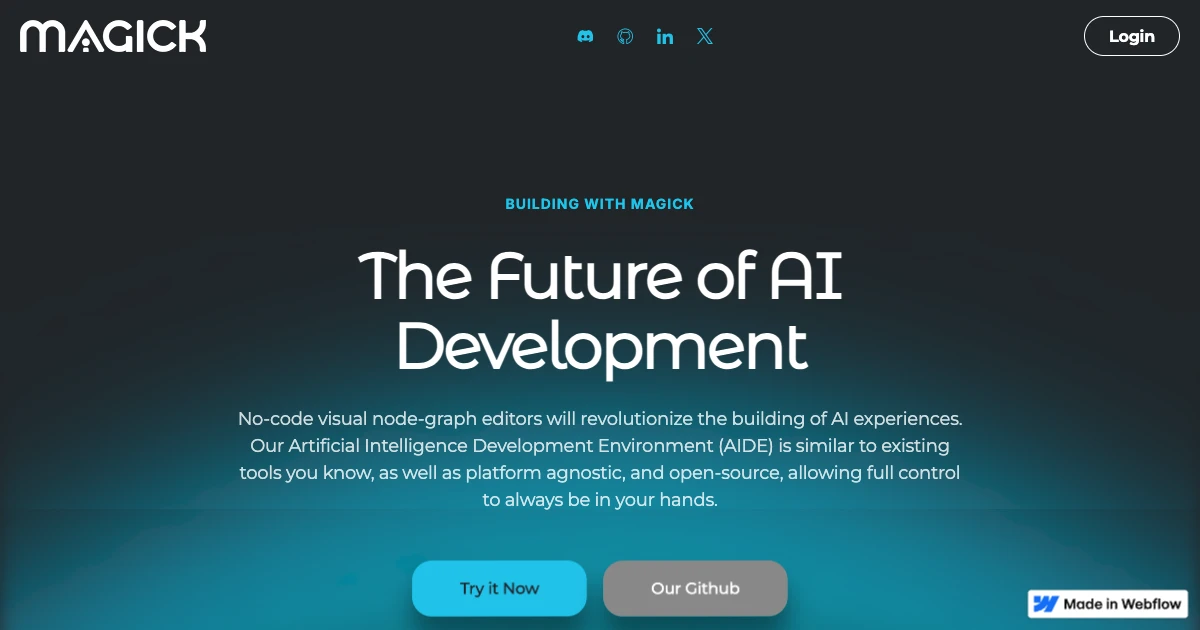Magick: Revolutionizing AI Development with Visual Tools
Magick is a state-of-the-art toolkit tailored for the next wave of AI innovators. It introduces a groundbreaking Visual Artificial Intelligence Development Environment (AIDE) that empowers users to effortlessly create data pipelines and multimodal agents without the need for manual coding. Whether your goal is to develop intelligent agents, interactive chatbots, advanced reasoning systems, or lifelike characters, Magick equips you with the resources to breathe life into your concepts.
Key Features
- Realtime Agents: Develop autonomous AI agents capable of independent actions, cross-modal interactions, and self-awareness.
- Social Connectors: Easily integrate with popular platforms like Discord, Twitter, and Twilio, with upcoming support for Zoom, Google Meet, Reddit, and Slack connectors through plugins.
- Web Integration: Seamlessly search across Google, Wikipedia, and the Semantic Web.
- Powerful Tools: Leverage a diverse set of powertools, including voice and image generation, and vector search functionalities.
- Graph-based IDE: Harness an intuitive interface for constructing intricate data pipelines.
- Community Development: Collaborate on graph embeddings for accelerated community-driven progress.
Core Concepts
Spells:In Magick, a 'spell' is a data pipeline detailing the flow of information through 'nodes' via connections. Spells contain data, nodes, variables, and presets tailored to a specific graph, enabling effortless importing, exporting, and sharing in JSON format.
Nodes:Nodes serve as the fundamental components of Magick, processing data inputs to produce desired outcomes. With various node types available, including Input Nodes, Prompt Templates, Code Nodes, Generator Nodes, and more, users have a plethora of tools at their disposal.
Inputs and Outputs:Nodes communicate through visually represented inputs and outputs known as sockets, colored according to the data type they manage, with gray signifying the default 'any' type.
Triggers:Triggers activate asynchronous tasks within nodes, with nodes like 'Wait For All' facilitating synchronization for efficient parallel processing.
Building with Magick
- Create Spells: Design AI pipelines effortlessly using the composer window in the 'Spells' tab.
- Add Nodes: Incorporate nodes by right-clicking in the composer or dragging them from the 'Nodes' tab.
- Connect Nodes: Forge connections between nodes to establish data flows and processing sequences.
- Customize: Fine-tune AI behavior by adjusting node properties and inputs.
- Test and Iterate: Execute spells, evaluate outcomes, and refine designs iteratively.
Benefits of Using Magick
- No-Code Solution: Develop intricate AI systems without extensive programming skills.
- Visual Interface: Simplify AI pipeline comprehension and modification through a graph-based design.
- Flexibility: Integrate multiple AI features and services within a unified environment.
- Rapid Prototyping: Quickly experiment with AI concepts using pre-built nodes and templates.
- Community-Driven: Collaborate and share spells to expedite progress and foster innovation.
Conclusion
Magick caters to both aspiring and seasoned AI enthusiasts by offering a platform to craft sophisticated AI systems sans extensive coding requirements. Its visual approach to AI development makes the field more inclusive to a broader demographic while retaining the potency and adaptability essential for ambitious projects. Whether your ambition lies in a basic chatbot or a multifaceted AI agent, Magick stands ready to materialize your aspirations.




